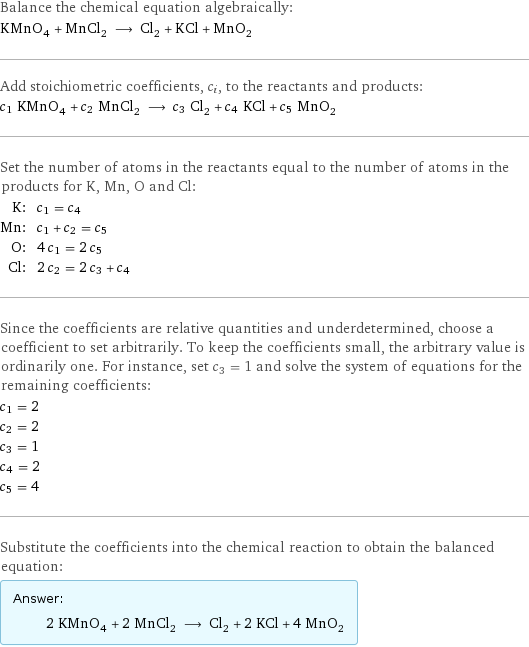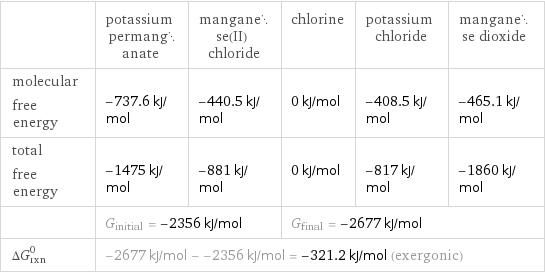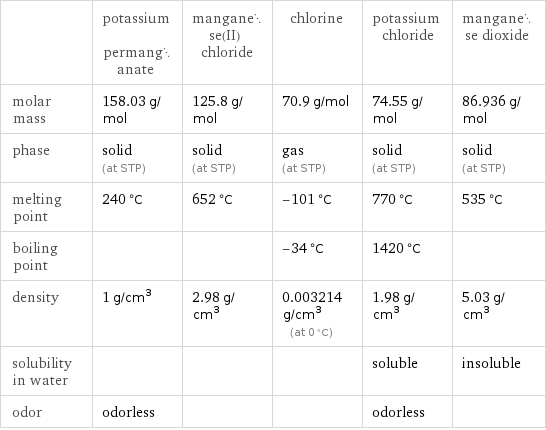Input interpretation

KMnO_4 potassium permanganate + MnCl_2 manganese(II) chloride ⟶ Cl_2 chlorine + KCl potassium chloride + MnO_2 manganese dioxide
Balanced equation

Balance the chemical equation algebraically: KMnO_4 + MnCl_2 ⟶ Cl_2 + KCl + MnO_2 Add stoichiometric coefficients, c_i, to the reactants and products: c_1 KMnO_4 + c_2 MnCl_2 ⟶ c_3 Cl_2 + c_4 KCl + c_5 MnO_2 Set the number of atoms in the reactants equal to the number of atoms in the products for K, Mn, O and Cl: K: | c_1 = c_4 Mn: | c_1 + c_2 = c_5 O: | 4 c_1 = 2 c_5 Cl: | 2 c_2 = 2 c_3 + c_4 Since the coefficients are relative quantities and underdetermined, choose a coefficient to set arbitrarily. To keep the coefficients small, the arbitrary value is ordinarily one. For instance, set c_3 = 1 and solve the system of equations for the remaining coefficients: c_1 = 2 c_2 = 2 c_3 = 1 c_4 = 2 c_5 = 4 Substitute the coefficients into the chemical reaction to obtain the balanced equation: Answer: | | 2 KMnO_4 + 2 MnCl_2 ⟶ Cl_2 + 2 KCl + 4 MnO_2
Structures

+ ⟶ + +
Names

potassium permanganate + manganese(II) chloride ⟶ chlorine + potassium chloride + manganese dioxide
Reaction thermodynamics
Gibbs free energy

| potassium permanganate | manganese(II) chloride | chlorine | potassium chloride | manganese dioxide molecular free energy | -737.6 kJ/mol | -440.5 kJ/mol | 0 kJ/mol | -408.5 kJ/mol | -465.1 kJ/mol total free energy | -1475 kJ/mol | -881 kJ/mol | 0 kJ/mol | -817 kJ/mol | -1860 kJ/mol | G_initial = -2356 kJ/mol | | G_final = -2677 kJ/mol | | ΔG_rxn^0 | -2677 kJ/mol - -2356 kJ/mol = -321.2 kJ/mol (exergonic) | | | |
Equilibrium constant
![Construct the equilibrium constant, K, expression for: KMnO_4 + MnCl_2 ⟶ Cl_2 + KCl + MnO_2 Plan: • Balance the chemical equation. • Determine the stoichiometric numbers. • Assemble the activity expression for each chemical species. • Use the activity expressions to build the equilibrium constant expression. Write the balanced chemical equation: 2 KMnO_4 + 2 MnCl_2 ⟶ Cl_2 + 2 KCl + 4 MnO_2 Assign stoichiometric numbers, ν_i, using the stoichiometric coefficients, c_i, from the balanced chemical equation in the following manner: ν_i = -c_i for reactants and ν_i = c_i for products: chemical species | c_i | ν_i KMnO_4 | 2 | -2 MnCl_2 | 2 | -2 Cl_2 | 1 | 1 KCl | 2 | 2 MnO_2 | 4 | 4 Assemble the activity expressions accounting for the state of matter and ν_i: chemical species | c_i | ν_i | activity expression KMnO_4 | 2 | -2 | ([KMnO4])^(-2) MnCl_2 | 2 | -2 | ([MnCl2])^(-2) Cl_2 | 1 | 1 | [Cl2] KCl | 2 | 2 | ([KCl])^2 MnO_2 | 4 | 4 | ([MnO2])^4 The equilibrium constant symbol in the concentration basis is: K_c Mulitply the activity expressions to arrive at the K_c expression: Answer: | | K_c = ([KMnO4])^(-2) ([MnCl2])^(-2) [Cl2] ([KCl])^2 ([MnO2])^4 = ([Cl2] ([KCl])^2 ([MnO2])^4)/(([KMnO4])^2 ([MnCl2])^2)](../image_source/0b0149e958a511291516aa6aa78fdeef.png)
Construct the equilibrium constant, K, expression for: KMnO_4 + MnCl_2 ⟶ Cl_2 + KCl + MnO_2 Plan: • Balance the chemical equation. • Determine the stoichiometric numbers. • Assemble the activity expression for each chemical species. • Use the activity expressions to build the equilibrium constant expression. Write the balanced chemical equation: 2 KMnO_4 + 2 MnCl_2 ⟶ Cl_2 + 2 KCl + 4 MnO_2 Assign stoichiometric numbers, ν_i, using the stoichiometric coefficients, c_i, from the balanced chemical equation in the following manner: ν_i = -c_i for reactants and ν_i = c_i for products: chemical species | c_i | ν_i KMnO_4 | 2 | -2 MnCl_2 | 2 | -2 Cl_2 | 1 | 1 KCl | 2 | 2 MnO_2 | 4 | 4 Assemble the activity expressions accounting for the state of matter and ν_i: chemical species | c_i | ν_i | activity expression KMnO_4 | 2 | -2 | ([KMnO4])^(-2) MnCl_2 | 2 | -2 | ([MnCl2])^(-2) Cl_2 | 1 | 1 | [Cl2] KCl | 2 | 2 | ([KCl])^2 MnO_2 | 4 | 4 | ([MnO2])^4 The equilibrium constant symbol in the concentration basis is: K_c Mulitply the activity expressions to arrive at the K_c expression: Answer: | | K_c = ([KMnO4])^(-2) ([MnCl2])^(-2) [Cl2] ([KCl])^2 ([MnO2])^4 = ([Cl2] ([KCl])^2 ([MnO2])^4)/(([KMnO4])^2 ([MnCl2])^2)
Rate of reaction
![Construct the rate of reaction expression for: KMnO_4 + MnCl_2 ⟶ Cl_2 + KCl + MnO_2 Plan: • Balance the chemical equation. • Determine the stoichiometric numbers. • Assemble the rate term for each chemical species. • Write the rate of reaction expression. Write the balanced chemical equation: 2 KMnO_4 + 2 MnCl_2 ⟶ Cl_2 + 2 KCl + 4 MnO_2 Assign stoichiometric numbers, ν_i, using the stoichiometric coefficients, c_i, from the balanced chemical equation in the following manner: ν_i = -c_i for reactants and ν_i = c_i for products: chemical species | c_i | ν_i KMnO_4 | 2 | -2 MnCl_2 | 2 | -2 Cl_2 | 1 | 1 KCl | 2 | 2 MnO_2 | 4 | 4 The rate term for each chemical species, B_i, is 1/ν_i(Δ[B_i])/(Δt) where [B_i] is the amount concentration and t is time: chemical species | c_i | ν_i | rate term KMnO_4 | 2 | -2 | -1/2 (Δ[KMnO4])/(Δt) MnCl_2 | 2 | -2 | -1/2 (Δ[MnCl2])/(Δt) Cl_2 | 1 | 1 | (Δ[Cl2])/(Δt) KCl | 2 | 2 | 1/2 (Δ[KCl])/(Δt) MnO_2 | 4 | 4 | 1/4 (Δ[MnO2])/(Δt) (for infinitesimal rate of change, replace Δ with d) Set the rate terms equal to each other to arrive at the rate expression: Answer: | | rate = -1/2 (Δ[KMnO4])/(Δt) = -1/2 (Δ[MnCl2])/(Δt) = (Δ[Cl2])/(Δt) = 1/2 (Δ[KCl])/(Δt) = 1/4 (Δ[MnO2])/(Δt) (assuming constant volume and no accumulation of intermediates or side products)](../image_source/dc2a6ea18f8f8bdbe85809b17a5617e6.png)
Construct the rate of reaction expression for: KMnO_4 + MnCl_2 ⟶ Cl_2 + KCl + MnO_2 Plan: • Balance the chemical equation. • Determine the stoichiometric numbers. • Assemble the rate term for each chemical species. • Write the rate of reaction expression. Write the balanced chemical equation: 2 KMnO_4 + 2 MnCl_2 ⟶ Cl_2 + 2 KCl + 4 MnO_2 Assign stoichiometric numbers, ν_i, using the stoichiometric coefficients, c_i, from the balanced chemical equation in the following manner: ν_i = -c_i for reactants and ν_i = c_i for products: chemical species | c_i | ν_i KMnO_4 | 2 | -2 MnCl_2 | 2 | -2 Cl_2 | 1 | 1 KCl | 2 | 2 MnO_2 | 4 | 4 The rate term for each chemical species, B_i, is 1/ν_i(Δ[B_i])/(Δt) where [B_i] is the amount concentration and t is time: chemical species | c_i | ν_i | rate term KMnO_4 | 2 | -2 | -1/2 (Δ[KMnO4])/(Δt) MnCl_2 | 2 | -2 | -1/2 (Δ[MnCl2])/(Δt) Cl_2 | 1 | 1 | (Δ[Cl2])/(Δt) KCl | 2 | 2 | 1/2 (Δ[KCl])/(Δt) MnO_2 | 4 | 4 | 1/4 (Δ[MnO2])/(Δt) (for infinitesimal rate of change, replace Δ with d) Set the rate terms equal to each other to arrive at the rate expression: Answer: | | rate = -1/2 (Δ[KMnO4])/(Δt) = -1/2 (Δ[MnCl2])/(Δt) = (Δ[Cl2])/(Δt) = 1/2 (Δ[KCl])/(Δt) = 1/4 (Δ[MnO2])/(Δt) (assuming constant volume and no accumulation of intermediates or side products)
Chemical names and formulas

| potassium permanganate | manganese(II) chloride | chlorine | potassium chloride | manganese dioxide formula | KMnO_4 | MnCl_2 | Cl_2 | KCl | MnO_2 Hill formula | KMnO_4 | Cl_2Mn | Cl_2 | ClK | MnO_2 name | potassium permanganate | manganese(II) chloride | chlorine | potassium chloride | manganese dioxide IUPAC name | potassium permanganate | dichloromanganese | molecular chlorine | potassium chloride | dioxomanganese
Substance properties

| potassium permanganate | manganese(II) chloride | chlorine | potassium chloride | manganese dioxide molar mass | 158.03 g/mol | 125.8 g/mol | 70.9 g/mol | 74.55 g/mol | 86.936 g/mol phase | solid (at STP) | solid (at STP) | gas (at STP) | solid (at STP) | solid (at STP) melting point | 240 °C | 652 °C | -101 °C | 770 °C | 535 °C boiling point | | | -34 °C | 1420 °C | density | 1 g/cm^3 | 2.98 g/cm^3 | 0.003214 g/cm^3 (at 0 °C) | 1.98 g/cm^3 | 5.03 g/cm^3 solubility in water | | | | soluble | insoluble odor | odorless | | | odorless |
Units
